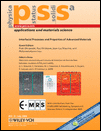Formation of aluminum silicate film on steel in granite–copper–dry steam reaction system
Abstract
We have observed that a highly protective amorphous aluminum silicate layer on a steel surface was formed after granite–dry steam interaction in the presence of a copper plate near the critical point of water. In this process, the mass transfer of aluminum and silicon species from the granite to the steel surface takes place after copper was transferred to the granite surface. The rate of this process is accelerated by the presence of copper on the granite surface. At present, we have determined the effect of transferred copper species on the weight loss of granite in dry steam with different ratios of O2 and N2. It was also found that transferred copper species at a low O2 level promote the weight loss of granite. Four types of experiments were conducted at low O2 ratios in different-density steam: (1) steel–steam, (2) steel–Cu–steam, (3) steel–granite–steam, and (4) steel–granite–Cu–steam. It was established that an aluminum silicate film formed on the steel surface only at the steel–granite–Cu–dry steam interaction. The formed film was characterized by scanning electron microscopy equipped with energy-dispersive X-ray spectroscopy and by X-ray photoelectron spectroscopy. (© 2006 WILEY-VCH Verlag GmbH & Co. KGaA, Weinheim)




